 W
WThe 1804 dollar or Bowed Liberty Dollar was a dollar coin struck by the Mint of the United States, of which fifteen specimens are currently known to exist. Though dated 1804, none were struck in that year; all were minted in the 1830s or later. They were first created for use in special proof coin sets used as diplomatic gifts during Edmund Roberts' trips to Siam and Muscat.
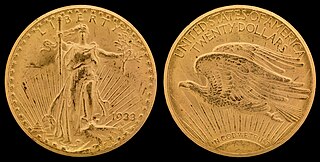 W
WThe 1933 double eagle is a United States 20-dollar gold coin. Although 445,500 specimens of this Saint-Gaudens double eagle were minted in 1933, none were ever officially circulated, and all but two were ordered to be melted down. However, 20 more are known to have been rescued from melting by being stolen and found their way into the hands of collectors before later being recovered. Nine of the recovered coins were destroyed, making this one of the world's rarest coins, with only 13 known specimens remaining—only one of which is privately owned.
 W
WThe Library of Congress bimetallic eagle is a modern U.S. commemorative coin issued in the ten dollar denomination. It is the first gold and platinum bimetallic coin to be issued by the United States Mint. It was issued in proof and business strike qualities.
 W
WThe Alabama Centennial half dollar, or Alabama half dollar, was a commemorative fifty-cent coin struck by the United States Bureau of the Mint in 1921 as a belated acknowledgement of the 100th anniversary of Alabama's admission to the Union in 1819. The coin was created by Laura Gardin Fraser, the first woman credited with designing a coin.
 W
WThe Albany Charter half dollar, also known as the Albany-Dongan half dollar or Albany half dollar, is a commemorative half dollar struck by the United States Bureau of the Mint in 1936. It was designed by sculptor Gertrude K. Lathrop, who lived in Albany, New York's state capital.
 W
WThe American Gold Eagle is an official gold bullion coin of the United States. Authorized under the Gold Bullion Coin Act of 1985, it was first released by the United States Mint in 1986. Because the term "eagle" also is the official United States designation for pre-1933 ten dollars gold coins, the weight of the bullion coin is typically used when describing American Gold Eagles to avoid confusion. This is particularly true with the 1/4-oz American Gold Eagle, which has a marked face value of ten dollars.
 W
WThe American Liberty high relief gold coin is a one-ounce gold bullion coin issued by the United States Mint since 2015. This coin was the first 100 dollar gold coin to be issued by the US Mint.
 W
WThe American Palladium Eagle is the official palladium bullion coin of the United States. Each coin has a face value of $25 and contains 99.95% fine palladium. It was authorized by the American Eagle Palladium Bullion Coin Act of 2010 which became Public Law 111-303 passed during the 111th United States Congress. The Palladium Eagle uses Adolph Weinman's obverse design on the Mercury dime, Liberty wearing a winged hat, while its reverse design is based on Weinman's 1907 American Institute of Architects (AIA) medal design.
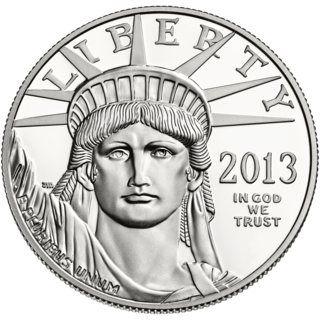 W
WThe American Platinum Eagle is the official platinum bullion coin of the United States. In 1995, Director of the United States Mint Philip N. Diehl, American Numismatic Association President David L. Ganz, and Platinum Guild International Executive Director Jacques Luben began the legislative process of creating the Platinum Eagle. After over two years of work, the 99.95% fine platinum coins were released by the United States Mint in 1⁄10, 1⁄4, 1⁄2 and 1 troy oz denominations. In late 2008, the fractional denominations were discontinued, leaving only the one ounce denomination. The Platinum Eagle is authorized by the United States Congress, and is backed by the United States Mint for weight, content, and purity.
 W
WThe American Silver Eagle is the official silver bullion coin of the United States.
 W
WThe Barber coinage consists of a dime, quarter, and half dollar designed by United States Bureau of the Mint Chief Engraver Charles E. Barber. They were minted between 1892 and 1916, though no half dollars were struck in the final year of the series.
 W
WOn May 16, 2008, in a vote of 403-8, the United States House of Representatives passed H.R. 5872, the Boy Scouts of America Centennial Commemorative Coin Act. The legislation included the following information:
 W
WThe Bridgeport, Connecticut, Centennial half dollar is a commemorative fifty-cent piece issued in 1936 by the United States Bureau of the Mint to honor the 100th anniversary of the incorporation of Bridgeport, Connecticut, as a city. Designed by Henry Kreis, the obverse depicts the showman P. T. Barnum, who was one of Bridgeport's most famous residents, was mayor of the city, helped develop it, and is buried there. The reverse depicts a stylized eagle.
 W
WThe loonie, formally the Canadian one-dollar coin, is a gold-coloured coin that was introduced in 1987 and is produced by the Royal Canadian Mint at its facility in Winnipeg. The most prevalent versions of the coin show a common loon, a bird found throughout Canada, on the reverse and Queen Elizabeth II, the nation's head of state, on the obverse. Various commemorative and specimen-set editions of the coin with special designs replacing the loon on the reverse have been minted over the years.
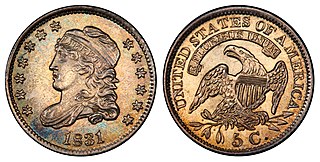 W
WThe Capped Bust coinage of the United States consisted of a half dime, dime, quarter and half dollar.
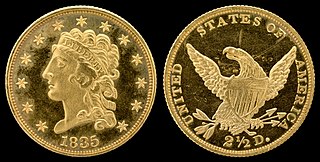 W
WThe Classic Head $2.50 gold coin is an American coin, also called a quarter eagle, minted from 1834-1839. It features Liberty on the obverse and an eagle on the reverse.
 W
WThe Connecticut Tercentenary half dollar, sometimes called the Connecticut half dollar, is a commemorative fifty-cent piece struck by the United States Bureau of the Mint in 1935. The coin was designed by Henry Kreis and commemorates the 300th anniversary of the founding of Connecticut. Its obverse depicts the Charter Oak, where according to legend Connecticut's charter was hidden to save it from being confiscated by the English governor-general. An eagle appears on the coin's reverse side.
 W
WThe District of Columbia and United States Territories quarters were a series of quarters minted by the United States Mint in 2009 to honor the District of Columbia and the unincorporated United States insular areas of Puerto Rico, Guam, the United States Virgin Islands, American Samoa, and the Northern Mariana Islands. The islands commonly grouped together as the United States Minor Outlying Islands were not featured, as the law defined the word "territory" as being limited to the areas mentioned above. They followed the completion of the 50 State Quarters Program. The coins used the same George Washington obverse as with the quarters of the previous 10 years. The reverse of the quarters featured a design selected by the Mint depicting the federal district and each territory. Unlike on the 50 State quarters, the motto "E Pluribus Unum" preceded and was the same size as the mint date on the reverse.
 W
WA double eagle is a gold coin of the United States with a denomination of $20. The coins are made from a 90% gold and 10% copper alloy and have a total weight of 1.0750 troy ounces.
 W
W"Draped Bust" was the name given to a design of United States coins. It appeared on much of the regular-issue copper and silver United States coinage, 1796–1807. It was designed by engraver Robert Scot.
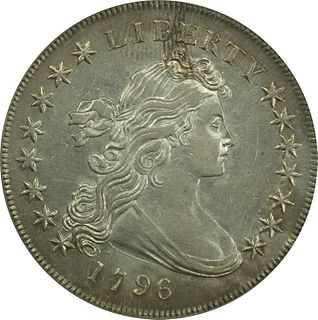 W
WThe Draped Bust dollar is a United States dollar coin minted from 1795 to 1803, and was reproduced, dated 1804, into the 1850s. The design succeeded the Flowing Hair dollar, which began mintage in 1794 and was the first silver dollar struck by the United States Mint. The designer is unknown, though the distinction is usually credited to artist Gilbert Stuart. The model is also unknown, though Ann Willing Bingham has been suggested.
 W
WThe eagle was a United States $10 gold coin issued by the United States Mint from 1792 to 1933.
 W
WThe Eisenhower dollar was a one-dollar coin issued by the United States Mint from 1971 to 1978; it was the first coin of that denomination issued by the Mint since the Peace dollar series ended in 1935. The coin depicts President Dwight D. Eisenhower on the obverse, and a stylized image honoring the 1969 Apollo 11 Moon mission on the reverse, with both sides designed by Frank Gasparro. It is the only large-size U.S. dollar coin whose circulation strikes contained no silver.
 W
WThe Flowing Hair dollar was the first dollar coin issued by the United States federal government. The coin was minted in 1794 and 1795; its size and weight were based on the Spanish dollar, which was popular in trade throughout the Americas.
 W
WThe Flying Eagle cent is a one-cent piece struck by the Mint of the United States as a pattern coin in 1856 and for circulation in 1857 and 1858. The coin was designed by Mint Chief Engraver James B. Longacre, with the eagle in flight based on the work of Longacre's predecessor, Christian Gobrecht.
 W
WThe Franklin half dollar is a coin that was struck by the United States Mint from 1948 to 1963. The fifty-cent piece pictures Founding Father Benjamin Franklin on the obverse and the Liberty Bell on the reverse. A small eagle was placed to the right of the bell to fulfill the legal requirement that half dollars depict the figure of an eagle. Produced in 90 percent silver with a reeded edge, the coin was struck at the Philadelphia, Denver, and San Francisco mints. As of April 26, 2019, the melt value of the $0.50 coin was approximately $5.46.
 W
WThe Gobrecht dollar, minted from 1836 to 1839, was the first silver dollar struck for circulation by the United States Mint since production of that denomination was officially halted in 1806. The coin was struck in small numbers to determine whether the reintroduced silver dollar would be well received by the public.
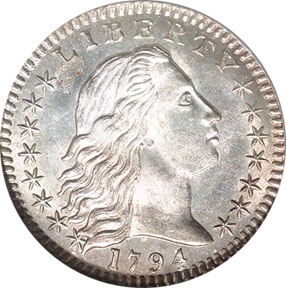 W
WThe half dime, or half disme, was a silver coin, valued at five cents, formerly minted in the United States.
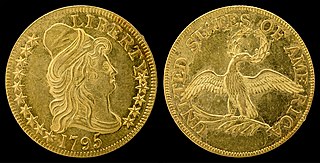 W
WThe half eagle is a United States coin that was produced for circulation from 1795 to 1929 and in commemorative and bullion coins since the 1980s. Composed almost entirely of gold, it has a face value of five dollars. Its production was authorized by The Act of April 2, 1792, and it was the first gold coin minted by the United States.
 W
WThe Half union was a United States coin minted as a pattern, or a coin not approved for release, with a face value of fifty U.S. Dollars. It is often thought of as one of the most significant and well-known patterns in the history of the U.S. Mint. The basic design, featuring Liberty on the obverse, was slightly modified from the similar $20 "Liberty Head" Double Eagle, which was designed by James B. Longacre and minted from 1849 to 1907.
 W
WThe Illinois Centennial half dollar is a commemorative 50-cent piece struck by the United States Bureau of the Mint in 1918. The obverse, depicting Abraham Lincoln, was designed by Chief Engraver George T. Morgan; the reverse, based on the Seal of Illinois, was by his assistant and successor, John R. Sinnock. Morgan's obverse is based on the statue by Andrew O'Connor.
 W
WThe Indian Head eagle was a $10 gold piece or eagle struck by the United States Mint continuously from 1907 until 1916, and then irregularly until 1933. The obverse and reverse were designed by sculptor Augustus Saint-Gaudens, originally commissioned for use on other denominations. He was suffering from cancer and did not survive to see the coins released.
 W
WThe Indian Head gold pieces or Pratt-Bigelow gold coins were two separate coin series, identical in design, struck by the United States Mint: a two-and-a-half-dollar piece, or quarter eagle, and a five-dollar coin, or half eagle. The quarter eagle was struck from 1908 to 1915 and from 1925–1929. The half eagle was struck from 1908 to 1916, and in 1929. The pieces remain the only US circulating coins with recessed designs. These coins were the last of their denominations to be struck for circulation, ending series that began in the 1790s.
 W
WThe Iowa Centennial half dollar was designed by Adam Pietz and minted in 1946. The reverse depicts the Iowa Old Capitol Building in Iowa City, and the obverse shows the state seal.
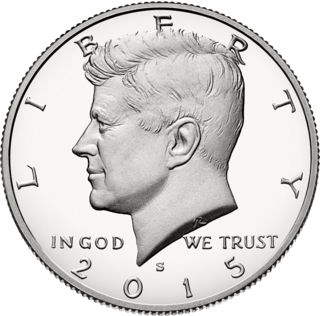 W
WThe Kennedy half dollar, first minted in 1964, is a fifty-cent coin currently issued by the United States Mint. Intended as a memorial to the assassinated 35th President of the United States John F. Kennedy, it was authorized by Congress just over a month after his death. Use of existing works by Mint sculptors Gilroy Roberts and Frank Gasparro allowed dies to be prepared quickly, and striking of the new coins began in January 1964.
 W
WThe Liberty Head double eagle or Coronet double eagle is an American twenty-dollar gold piece struck as a pattern coin in 1849, and for commerce from 1850 to 1907. It was designed by Mint of the United States Chief Engraver James B. Longacre.
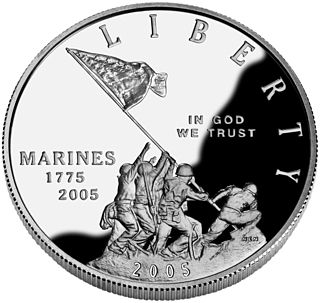 W
WIn 2005, the United States Mint released a silver dollar commemorative coin in honor of the 230th birthday of the United States Marine Corps.
 W
WThe Morgan dollar was a United States dollar coin minted from 1878 to 1904, in 1921, and as a special non-circulating coin in 2021. It was the first standard silver dollar minted since the passage of the Coinage Act of 1873, which ended the free coining of silver and the production of the previous design, the Seated Liberty dollar. The coin is named after its designer, United States Mint Assistant Engraver George T. Morgan. The obverse depicts a profile portrait representing Liberty, modeled by Anna Willess Williams, while the reverse depicts an eagle with wings outstretched. The mint mark, if present, appears on the reverse above the "o" in "Dollar".
 W
WThe Noah's Ark silver coins are Armenian bullion coins issued since 2011. They are available in various sizes with a fine weight between 1⁄4 ounce and 5 kg in silver of 999/1000 fineness. The 1 oz. coin has a nominal value of 500 Drams and is a legal tender in Armenia. The coin is produced by the Leipziger Edelmetallverarbeitungs GmbH, an affiliated company of Geiger Edelmetalle. The motif of the coin remains constant, similar to other bullion coins such as the Canadian Silver Maple Leaf, the Vienna Philharmonic, or the American Silver Eagle.
 W
WIn Greek mythology, a little owl traditionally represents or accompanies Athena, the virgin goddess of wisdom, or Minerva, her syncretic incarnation in Roman mythology. Because of such association, the bird—often referred to as the "owl of Athena" or the "owl of Minerva"—has been used as a symbol of knowledge, wisdom, perspicacity and erudition throughout the Western world.
 W
WThe five Panama–Pacific commemorative coins were produced in connection with the 1915 Panama–Pacific International Exposition in San Francisco. Struck at that city's mint, the issue included round and octagonal $50 pieces. Excepting modern bullion coins, these two gold pieces are the highest denomination ever issued and the largest coins ever struck by the United States Mint. The octagonal $50 piece is the only U.S. coin to be issued that is not round.
 W
WThe Peace dollar is a United States dollar coin minted from 1921 to 1928, in 1934 and 1935, and as a commemorative in 2021. Designed by Anthony de Francisci, the coin was the result of a competition to find designs emblematic of peace. Its obverse represents the head and neck of the Goddess of Liberty in profile, and the reverse depicts a bald eagle at rest clutching an olive branch, with the legend "Peace". It was the last United States dollar coin to be struck for circulation in silver.
 W
WThe quarter eagle was a gold coin issued by the United States with a denomination of two hundred and fifty cents, or two dollars and fifty cents. It was given its name in the Coinage Act of 1792, as a derivation from the US ten-dollar eagle coin. Its purchasing power in 1800 would be equivalent to $71.12 in 2015 dollars.
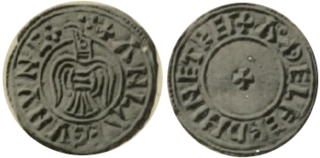 W
WThe Raven Penny is a coin of the Viking Olaf Guthfrithson who was the king of Dublin between 934–941.
 W
WThe Sacagawea dollar is a United States dollar coin first minted in 2000, although not minted for general circulation between 2002 to 2008 and again from 2012 onward due to its general unpopularity with the public and low business demand for the coin. These coins have a copper core clad by manganese brass, giving them a distinctive golden color. The coin features an obverse by Glenna Goodacre. From 2000 to 2008, the reverse featured an eagle design by Thomas D. Rogers. Since 2009, the reverse of the Sacagawea dollar has been changed yearly, with each design in the series depicting a different aspect of Native American cultures. These coins are marketed as "Native American dollars".
 W
WThe Saint-Gaudens double eagle is a twenty-dollar gold coin, or double eagle, produced by the United States Mint from 1907 to 1933. The coin is named after its designer, the sculptor Augustus Saint-Gaudens, who designed the obverse and reverse. It is considered by many to be the most beautiful of U.S. coins.
 W
WThe Seated Liberty dollar was a dollar coin struck by the United States Mint from 1840 to 1873 and designed by its chief engraver, Christian Gobrecht. It was the last silver coin of that denomination to be struck before passage of the Coinage Act of 1873, which temporarily ended production of the silver dollar for American commerce. The coin's obverse is based on that of the Gobrecht dollar, which had been minted experimentally from 1836 to 1839. However, the soaring eagle used on the reverse of the Gobrecht dollar was not used; instead, the United States Mint (Mint) used a heraldic eagle, based on a design by late Mint Chief Engraver John Reich first utilized on coins in 1807.
 W
WThe Standing Liberty quarter is a 25-cent coin that was struck by the United States Mint from 1916 to 1930. It succeeded the Barber quarter, which had been minted since 1892. Featuring the goddess of Liberty on one side and an eagle in flight on the other, the coin was designed by American sculptor Hermon Atkins MacNeil.
 W
WThe United States four dollar coin, also officially called a Stella, is a unit of currency equivalent to four United States dollars.
 W
WThe Stone Mountain Memorial half dollar was an American fifty-cent piece struck in 1925 at the Philadelphia Mint. Its main purpose was to raise money on behalf of the Stone Mountain Confederate Monumental Association for the Stone Mountain Memorial near Atlanta, Georgia. Designed by sculptor Gutzon Borglum, the coin features a depiction of Confederate generals Robert E. Lee and Stonewall Jackson on the obverse and the caption: "Memorial to the Valor of the Soldier of the South" on the reverse. The piece was also originally intended to be in memory of the recently deceased president, Warren G. Harding, but no mention of him appears on the coin.
 W
WThe Susan B. Anthony dollar is a United States dollar coin minted from 1979 to 1981, when production was suspended due to poor public acceptance, and then again in 1999. Intended as a replacement for the larger Eisenhower dollar, the new smaller one-dollar coin went through testing of several shapes and compositions, but all were opposed by the vending machine industry, a powerful lobby affecting coin legislation. Finally, a round planchet with an eleven-sided inner border was chosen for the smaller dollar.
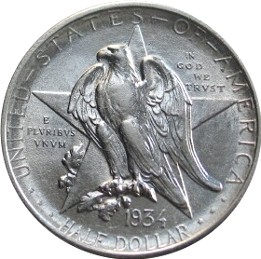 W
WThe Texas Centennial half dollar commemorative coin was minted to honor the Centennial of Texas's independence from Mexico. Early in the administration of President Franklin Delano Roosevelt, on June 15, 1933, Congress passed an act to authorize the coinage of silver half dollars "in commemoration of the one hundredth anniversary in 1936 of the independence of Texas, and of the noble and heroic sacrifices of her pioneers, whose revered memory has been an inspiration to her sons and daughters during the past century." This was the first of over two dozen commemorative bills that would become reality during Roosevelt's tenure. The legislation provided that "no more than one and a half million pieces" be created on behalf of the American Legion Texas Centennial Committee, located in Austin in that state.
 W
WThe United States trade dollar was a dollar coin minted by the United States Mint to compete with other large silver trade coins that were already popular in East Asia. The idea first came about in the 1860s, when the price of silver began to decline due to increased mining efforts in the western United States. A bill providing in part for the issuance of the trade dollar was eventually put before Congress, where it was approved and later signed into law as the Coinage Act of 1873. The act made trade dollars legal tender up to five dollars. A number of designs were considered for the trade dollar, and an obverse and reverse created by William Barber were selected.
 W
WThe Turban Head eagle, also known as the Capped Bust eagle, was a ten-dollar gold piece, or eagle, struck by the United States Mint from 1795 to 1804. The piece was designed by Robert Scot, and was the first in the eagle series, which continued until the Mint ceased striking gold coins for circulation in 1933. The common name is a misnomer; Liberty does not wear a turban but a cap, believed by some to be a pileus or Phrygian cap : her hair twisting around the headgear makes it resemble a turban.
 W
WThe American twenty-cent piece is a coin struck from 1875 to 1878, but only for collectors in the final two years. Proposed by Nevada Senator John P. Jones, it proved a failure due to confusion with the quarter, to which it was close in both size and value.
 W
WThe two-cent billon was a pattern US coin struck in 1836 and initially proposed as part of the Act of January 13, 1837. Versions exist with either a reeded edge and coin orientation or a plain edge and medal orientation; however, those with the former tend to be original strikes, whereas the latter are always proof restrikes.
 W
WThe Union was a proposed $100 coin of the United States dollar. It was canceled before any pattern coins could be minted.
 W
WThe USO 50th Anniversary silver dollar is a commemorative silver dollar issued by the United States Mint in 1991.
 W
WThe Walking Liberty half dollar is a silver 50-cent piece or half dollar coin that was issued by the United States Mint from 1916 to 1947; it was designed by Adolph A. Weinman, a well-known sculptor and engraver.
 W
WThe Washington quarter is the present quarter dollar or 25-cent piece issued by the United States Mint. The coin was first struck in 1932; the original version was designed by sculptor John Flanagan.